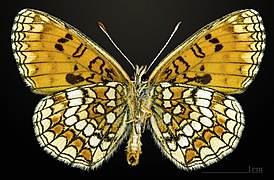Quail wheat piebald butterflies
| Quail wheat piebald butterflies | ||||||||||||
|---|---|---|---|---|---|---|---|---|---|---|---|---|

Quail Wheat Butterfly ( Melitaea athalia ) |
||||||||||||
| Systematics | ||||||||||||
|
||||||||||||
| Scientific name | ||||||||||||
| Melitaea athalia | ||||||||||||
| ( Rottemburg , 1775) |
The quail wheat butterfly ( Melitaea athalia ), also known as the common scheckenfalter is a butterfly ( butterfly ) from the family of the noble butterfly (Nymphalidae).
features
The coloring and drawing of the moths are very variable, which means that they can often only be reliably distinguished from the similar species listed below by means of a microscopic genital examination . The upper sides of the wings are ocher colored and have a dark brown to black grid-like pattern. White shapes are also described. On the underside of the hind wing, the space between the two marginal lines is light yellow. The palps are colored black. The moths reach a wingspan of 35 - 40 mm.
Similar species
- Lesser Scheckenfalter ( Melitaea asteria )
- Speedwell piebald ( Melitaea aurelia )
- Eastern pied butterfly ( Melitaea britomartis )
- Valerian-Scheckenfalter or Silberscheckenfalter ( Melitaea diamina )
- Bündner Scheckenfalter ( Melitaea varia )
- Melitaea deione
Subspecies
- Melitaea athalia norvegica Aurivillius, 1888, found in Norway , Sweden and Finland .
- Melitaea athalia caledussa Fruhstorfer, 1910, with occurrence in Italy with Sicily , Portugal , Spain and the Sierra Nevada as well as in southern France .
Flight time
One generation of the quail wheat piebald flies from May to August, and earlier in southern countries. In favorable years, a partial second generation occurs from mid-August to September.
habitat
According to Ebert, the quail wheat butterfly can be found in the following habitats: semi-arid grassland on slopes rich in bushes ( juniper heaths ), path and forest edges, abandoned vineyards and quarries, wet meadows on the edge of moors , sloping moors and spring meadows . Likewise in mesophilic areas.
Way of life
The eggs are laid in clutches on the underside of the leaves. The caterpillars prefer to feed on meadow quail wheat ( Melampyrum pratense ), meadow eyebright ( Euphrasia rostkoviana ) and Norway plantain ( Plantago lanceolata ) and overwinter in silk fabrics. Pupation takes place on leaves or stems near the ground. The moths suckle on the flowers of the swamp thistle ( Cirsium palustre ) and the meadow knapweed ( Centaurea jacea ). Common dost ( Origanum vulgare ), field thyme ( Thymus pulegioides ), meadow knapweed ( Centaurea jacea ), scabiosa knapweed ( Centaurea scabiosa ), arnica ( Arnica montana ), devil's bite ( Succisa pratensis ) and meadows are used for food crops in dry areas Knotweed ( Polygonum bistorta ).
distribution
The quail wheat piebald butterfly is common and widespread. Its distribution area covers almost all of northern Europe with southern England and extends in the south to the Pyrenees , Italy , Slovenia and the European part of Turkey .
- Red List Germany: 3 (endangered)
- Baden-Württemberg Red List: 3 (endangered)
supporting documents
Individual evidence
- ↑ Melitaea athalia [1] at leps.it
- ↑ Günter Ebert (Ed.): The butterflies of Baden-Württemberg Volume 1, Tagfalter I (Ritterfalter (Papilionidae), Weißlinge (Pieridae), Edelfalter (Nymphalidae)), Ulmer Verlag Stuttgart 1993. ISBN 3-800-13451-9
- ↑ Federal Agency for Nature Conservation (Ed.): Red List of Endangered Animals in Germany. Landwirtschaftsverlag, Münster 1998, ISBN 978-3-896-24110-8
literature
- Tom Tolman, Richard Lewington: The butterflies of Europe and Northwest Africa , Franckh-Kosmos Verlags-GmbH & Co, Stuttgart 1998, ISBN 3-440-07573-7
- Hans-Josef Weidemann: Butterfly: observe, determine , Naturbuch-Verlag Augsburg 1995, ISBN 3-894-40115-X
Web links
- Lepiforum e. V. Taxonomy and Photos
- Moths and Butterflies of Europe and North Africa (English)
- Melitaea athalia at Fauna Europaea




